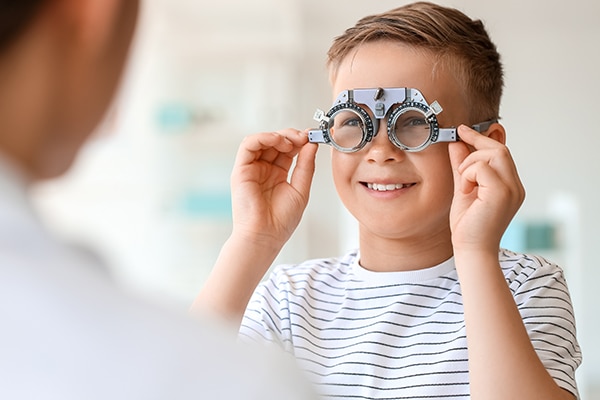Pediatric Eye Care

Thorough eye examinations by an experienced pediatric ophthalmologist can help ensure that your children experience the highest quality of vision. At Eye Consultants of Northern Virginia, our eye doctors have the knowledge and expertise to diagnose and treat pediatric eye conditions.
What is Pediatric Ophthalmology?
Pediatric ophthalmology is a subspecialty of ophthalmology that focuses on children’s ocular medical care and the process of diagnosing and treating eye conditions that develop in children. At Eye Consultants of Northern Virginia, our eye doctors perform ocular medical examinations on children upon referral from their primary care optometrist or pediatrician.
During a pediatric eye examination, your child’s eye doctor will perform a series of tests, obtain measurements and will dilate their eyes for a thorough medical evaluation. Exams can take up to 1 ½ to 2 hours. After, they will determine how frequently your child needs to be seen to ensure optimal vision based on their visual needs and possible diagnoses.
What Are Some of the Common Pediatric Eye Conditions?
There are many eye conditions that can arise in childhood or be present at birth. It is essential to have your child seen by a dedicated and experienced eye doctor for adequate treatment and to preserve vision.
At Eye Consultants of Northern Virginia, our eye doctors treat many pediatric eye conditions, including:
Amblyopia
Amblyopia is a common eye condition that often presents in childhood as the eyes develop. Someone who has amblyopia has an eye that does not develop properly, which causes reduced vision.
When the brain recognizes that one eye does not produce quality vision, it begins to heavily rely on the other eye that has quality vision. When the brain does not utilize the weaker eye, it begins to engage that eye’s muscles infrequently.
Due to this, the weaker eye can begin to wander and drift out, in, up, or down. With early treatment, eye doctors can help strengthen the muscles in the weaker eye and train the brain to use it more.
Strabismus
Strabismus is a common eye condition that can present in adulthood but frequently shows beginning signs in childhood. Those with strabismus may have one or both eyes that turn out, in, up, or down to varying degrees.
Strabismus often occurs due to weak eye muscles, which causes ocular misalignment. Ocular misalignment is another way to say that the eyes are not aligned.
Ocular misalignment can cause a variety of visual symptoms, including double vision. Eye doctors use many treatment methods to help improve or resolve strabismus, including surgery if necessary.
Pediatric Cataracts
Although cataracts typically occur later in life, they can also develop in childhood. In some cases, cataracts may be present at birth in one or both eyes in an infant.
If cataracts are present at birth, it is called congenital cataracts. Regardless of age, cataracts are caused when the eye’s natural lens becomes cloudy and hardened, which causes blurry vision.
Certain factors like genetics or eye injury may cause a cataract to form in childhood or infancy. Depending on the severity of cataracts, eye doctors determine the treatment method.
If the cataracts are mild and not significantly interfering with vision, they may continue to monitor them. However, cataract surgery is required to produce clear and crisp vision in many cases.
Eyelid Abnormalities
As a child’s eye grows and changes, they may develop abnormalities in the eyelid that can affect vision and adequate eye surface lubrication. One of the most common eyelid abnormalities that occur in children is pediatric ptosis, which is when one or both of the child’s eyelids droop.
A drooping eyelid can affect vision by limiting the visual field and, in some cases, obscuring the child’s central vision. Other eyelid conditions that can occur in children include blepharitis which is inflammation of the eyelids.
This can cause itching, crusting, and swelling in the eyelids. Eye doctors can use various methods to treat eyelid abnormalities, depending on the condition.
Refractive Errors

Although some people do not develop issues with refractive errors until adolescents, children can develop refractive errors and experience blurry vision due to them. If your child’s teacher notices signs of vision struggles, they may recommend a vision screening to determine if there is a vision deficit.
These vision issues are related to refractive errors such as nearsightedness, farsightedness, or astigmatism. Once your child’s eye doctor can perform an evaluation, they will be able to determine what glasses prescription will best correct your child’s vision.
Nasolacrimal Duct Obstruction
Like other pediatric eye conditions, nasolacrimal duct obstruction can occur at any age, including childhood. Nasolacrimal duct obstruction occurs when the eye’s natural drainage channel for tears is blocked or obstructed.
When these tears are unable to drain from the eye properly, it can cause excessive tearing and discharge. Many different factors can cause this obstruction.
However, eye doctors can easily treat this condition to improve symptoms in most cases.
Retinopathy of Prematurity
Retinopathy of prematurity, also known as ROP, is an eye condition that develops in babies born prematurely. In infants with retinopathy of prematurity, abnormal blood vessels develop in the light-sensitive tissue at the back of the eye called the retina.
For many babies diagnosed with ROP, treatment is unnecessary and will resolve naturally. However, ROP can lead to severe vision loss in more advanced cases and require treatment.
Pediatric Glaucoma
Glaucoma is a chronic eye condition that can cause progressive and permanent vision loss if left untreated. Pediatric glaucoma occurs in children when damage is caused to the optic nerve.
Damage to the optic nerve from glaucoma is often caused by consistently elevated pressure inside the eye. The damage to the optic nerve can cause permanent vision damage, and treatment is often required to preserve vision.
Pediatric eye doctors usually begin treatment of pediatric glaucoma by prescribing medicated eye drops. The primary objective of any glaucoma treatment is to prevent further vision loss by lowering eye pressure.
Keratoconus
Keratoconus is a progressive eye condition that occurs when the cornea, the transparent window at the front of the eye, is shaped more like a cone rather than a sphere. Those who have keratoconus often have a very weak and delicate cornea, mainly at the peak of the cone.
Eye doctors utilize specialty contact lenses in children with keratoconus to produce the best vision. If the condition progresses, your child may need further treatment, such as corneal cross-linking.
These types of interventions can help halt the progression of keratoconus. Keratoconus can also be present in adolescence and adulthood.
Close monitoring of the condition is often recommended to ensure the condition is not worsening.
Juvenile Idiopathic Arthritis
Juvenile idiopathic arthritis is the most common form of arthritis in children. Certain types of juvenile idiopathic arthritis can cause complications, including eye issues.
Some forms of arthritis in children may cause eye inflammation. Untreated inflammation in the eye can eventually lead to the development of other eye issues such as glaucoma and cataracts.
Do you want to learn more about keeping your child’s eyes healthy and ensuring their vision is clear? Schedule an appointment at Eye Consultants of Northern Virginia in Springfield, VA, today!
